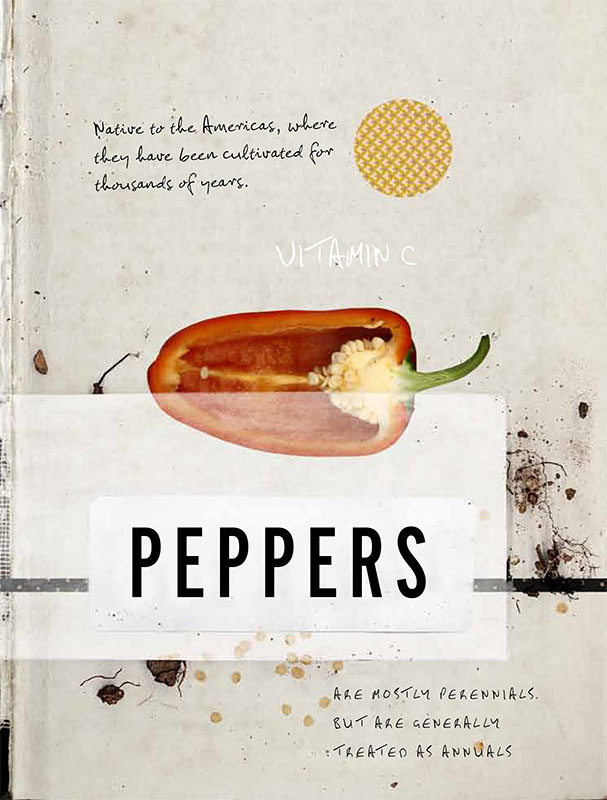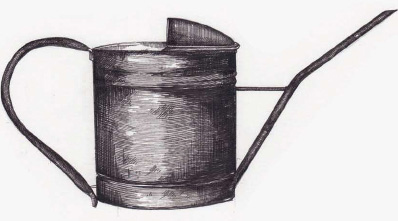
Peppers are a very lovely decorative plant with such vibrant color. The pepper (or capsicum) is a very close relative to the chili and comes in a rainbow of colors: red, green, orange, yellow and even purple. They originated in the Americas, where good old Chris Columbus picked them up and brought them back to Spain, where they were heartily embraced. Except by me.
RECIPES
PIQUILLO PEPPER, CHORIZO & MANGO SALAD WITH SEARED RARE TUNA
SIMPLE ROASTED PEPPERS TURNED INTO ROMESCO SAUCE
BAKED LONG GREEN PEPPERS, COUSCOUS & CURRANTS
I am going to go straight ahead and say for the record I hate peppers, raw or cooked. Hell to me would be a final meal of roasted peppers. The first thought that crosses my mind is “World’s Worst Food,” not something I’m partial to having included in Mr. Wilkinson’s Vegetables. It was only under the editorial guidance from my publisher that I began to consider including peppers. Mainly because so many people out there love it. So, I went away and thought about this, and then, after reflecting on it, I realized just how many recipes I did have for peppers—either in a sauce or as an accompaniment. There were at least 20, which I have shortlisted down to the three in this chapter.
I think my initial hesitation is because they just weren’t in my cultural repertoire growing up. My family never used them. And then, in the mid-nineties, thanks to the likes of River Café and Antonio Carluccio, there was a renaissance, an embracing of Italian food in England, with eggplant, fennel and peppers appearing on just about every menu. They were overused at the time, and that is probably why I have habitually steered away from them. They are nice in a traditional dish like ratatouille, but then again I have had some seriously bad ratatouille in my time, and it also seemed that if you walked into any British pub, the side salad would consist of grated carrot, iceberg lettuce, a slice of cucumber and diced green peppers, which (I’m sorry to say) is disgusting no matter what you do with it. It just seems like peppers, when prepared badly and without care, can be their own worst enemy: bitter seeds, indigestible skin.
Thankfully, there are some things you can do to make peppers much more attractive and palatable, and these are really very simple. Roasting or charring and peeling away the skin removes some of the bitter flavor and toughness. Also discard the seeds, and just use the lovely flesh. Just by exposing the flesh to heat, it becomes softer and releases its natural oils, which is where a lot of the flavor lies. There are also some amazing preserved varieties you can pick up. Of these, I like using piquillo peppers, which are small, sweet and slightly spicy peppers from Spain. They are already pre-roasted and peeled, making life very easy indeed. You should be able to find them at any good deli.
Having just explained my dislike of peppers, they are, in fact, a really lovely plant to grow, but they weren’t something that I inherited a passion for from Dad and Grandad, as with the many other things I like to grow. It was when I moved to London in 1996 for work that I began to grow them on my windowsill to add a little color to the place. I never really used them but would give them to friends. I just liked to grow them. They can tolerate a small space if they have enough sun, making them perfect for a window box or even just inside the window on the sill.
In more recent times, I have been particularly successful in growing peppers—it seems not too many critters like to nip at them except the little red spider. To achieve full ripeness through summer, planting earlier in cooler climates gives them a little head start.
When harvesting make sure you snip off the fruit with scissors otherwise when you’re trying to pull off the fruit, you might end up pulling out the whole plant (which happened to me with a cucumber once).
As I have said earlier, the pepper is truly a beautiful plant to grow and certainly has that “oooh-ahhh” factor for children and adults alike when the fruit starts off green (all varieties do), then turns into amazing colors of purple, red and orange.

PIQUILLO PEPPER, CHORIZO & MANGO SALAD WITH SEARED RARE TUNA
SERVES 4 AS AN ENTRÉE
This was a dish that was a highlight on the Circa menu when I first took over as head chef. It is amazing how well fruit lends itself to savory dishes at times and this is one of them. The mango really freshens up the rustic Mediterranean flavors of this dish. Piquillo peppers can be purchased in most specialty food shops.
1 FRESH CHORIZO, PEELED AND CUT INTO ¾ INCH CUBES
⅓ CUP GRAPESEED OIL
½ MANGO, FINELY DICED
½ SMALL RED ONION, FINELY DICED
14 OUNCE JAR PIQUILLO PEPPERS, DRAINED AND FINELY DICED
JUICE OF 1 LEMON
2 TABLESPOONS FINELY CHOPPED ITALIAN PARSLEY
3 TABLESPOONS OLIVE OIL
4 × 3½ OUNCES PIECES OF TUNA LOIN (ASK YOUR FISHMONGER TO PREP THESE FOR YOU WITHOUT ANY BLOODLINE)
SEA SALT AND FRESHLY GROUND BLACK PEPPER
1 CUP BABY WILD ARUGULA LEAVES
Heat a large skillet over medium heat. Once hot, add the chorizo and grapeseed oil and pan fry until colored on all sides, then take off the heat and strain, reserving the oil and chorizo. Set aside. The addition of the grapeseed oil will make a lovely dressing for the salad and garnish for the plate.
Place the mango, onion, peppers, half of the lemon juice and all the parsley in a large bowl and add enough of the reserved chorizo oil to bind everything. Arrange the salad onto each serving plate in a sporadic fashion. Arrange the cooked chorizo pieces around the plate as well.
Heat a large skillet over high heat. Add the olive oil and sear the tuna on one side until it is cooked halfway. Take off the heat, glaze the tuna with a little chorizo oil and the remaining lemon juice and season with salt and pepper. Place a piece of tuna onto each plate (or you could cut the tuna into 3 pieces first), then scatter over some arugula. Just before serving, drizzle the plate with a little more chorizo oil.
SIMPLE ROASTED PEPPERS TURNED INTO ROMESCO SAUCE
MAKES ABOUT 3 CUPS OF SAUCE
This recipe is a nice and easy way to roast peppers. For the romesco sauce, I add quince paste to give it a sweet and earthy flavor. The sauce goes great with all pork dishes and vegetables and is also lovely with crayfish, but is just as delicious as a simple dip.
5 RED PEPPERS (ABOUT 1 POUND 14 OUNCES)
⅓ CUP OLIVE OIL
2 SPRIGS OREGANO
2 SPRIGS THYME
SEA SALT AND FRESHLY GROUND BLACK PEPPER
Preheat the oven to 425°F. Place all the ingredients in a roasting tray and mix together. Roast for 40–50 minutes, shaking every 8 minutes or so until the peppers become soft and the skins are nicely browned. Take out of the oven, cover with foil and leave to rest for 10 minutes. This keeps the moisture within the peppers and makes them easier to peel. After 10 minutes, carefully peel and remove all the seeds. Add the roasted flesh to salads or I like to turn it into romesco.
1 POUND 5 OUNCES ROASTED PEPPER FLESH (NO SKIN OR SEEDS) (SEE RECIPE ABOVE)
⅓ CUP QUINCE PASTE
⅓ CUP ORGANIC RAW ALMONDS, BLANCHED IN BOILING WATER, THEN PEELED AND CHOPPED
1 GARLIC CLOVE
1 PINCH OF FENNEL SEEDS
1 PINCH OF CORIANDER SEEDS
1 PINCH OF NIGELLA SEEDS (ALSO KNOWN AS BLACK CUMIN OR KALONJI SEEDS)
1 PINCH OF CUMIN SEEDS
1 PINCH OF SUMAC
1 PINCH FINE SEA SALT
¾ CUP EXTRA VIRGIN OLIVE OIL
1½ TABLESPOONS CABERNET VINEGAR
Blitz the pepper flesh, quince paste, almonds and garlic to a purée in a food processor. Add the spices and salt and blitz again. Pour into a bowl, then fold in the oil and vinegar. It may require a little more vinegar to taste and some extra seasoning. This will keep well in the fridge for up to 1 week in an airtight container.
BAKED LONG GREEN PEPPERS, COUSCOUS & CURRANTS
SERVES 4
One of my closest and best friends chef Nicolas Poelaert had a version of this dish on his menu at Embrasse restaurant and I loved it that much I thought I would interpret it into my own version, so here it is.
½ CUP COUSCOUS
6 LONG GREEN SWEET PEPPERS (ABOUT 9 OUNCES EACH)
1 TABLESPOON PUMPKIN SEEDS
1½ TABLESPOONS PINE NUTS
1½ TABLESPOONS CHOPPED ALMONDS
2 TABLESPOONS CURRANTS
1 TABLESPOON MINT LEAVES, CHOPPED
1 TABLESPOON ITALIAN PARSLEY LEAVES, CHOPPED
2 TABLESPOONS EXTRA VIRGIN OLIVE OIL, PLUS EXTRA FOR DRIZZLING
SEA SALT AND FRESHLY GROUND BLACK PEPPER
2¼ OUNCES HALOUMI, CUT INTO SMALL DICE
Preheat the oven to 375°F.
Place the couscous in a heatproof bowl and add ½ cup of water. Stir with a fork for 20 seconds, cover with plastic wrap and leave for 2–3 minutes, then stir again to release all the grains. Put to the side.
Trim the tops off the peppers, only ½–¾ inch from the top and set the tops aside. Insert a small knife inside the pepper and cut out the seeds and membrane. Turn upside down and shake or gently tap until all the seeds have fallen out.
Add the remaining ingredients to the couscous and mix thoroughly. Carefully spoon the mixture into the peppers, compacting it with your finger, then place the tops back on. Place in a small ovenproof baking dish and bake for 30–35 minutes or until the peppers are soft and browned. Take out of the tray and present on a platter to serve. I would highly recommend some simple salad leaves with this dish and, if you’re feeling a wee adventurous, try with the tomato kasundi (see recipe).